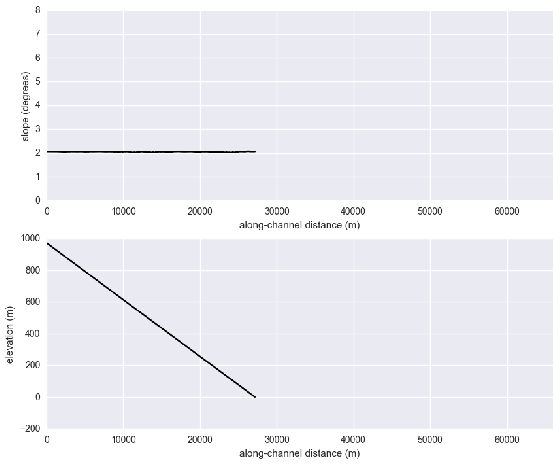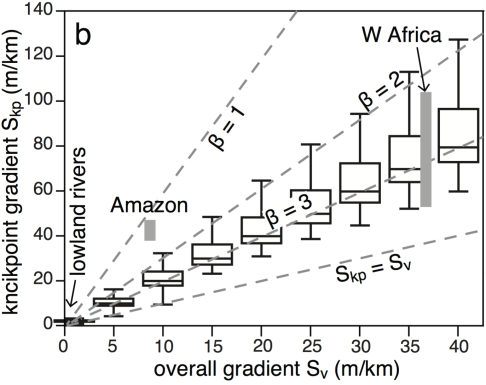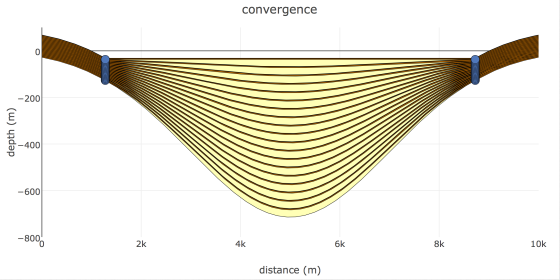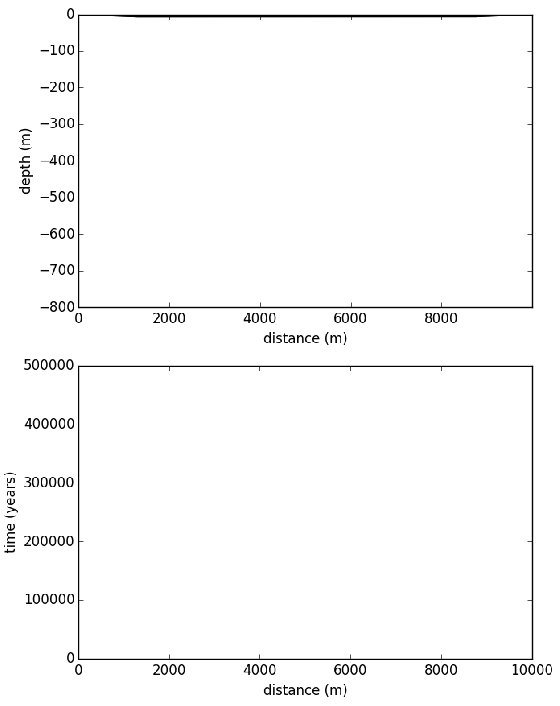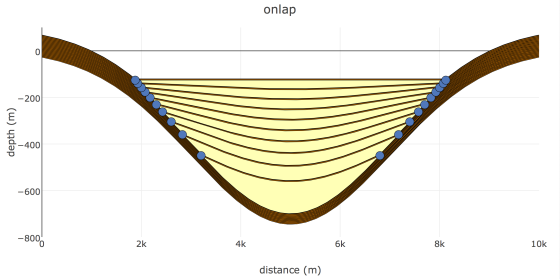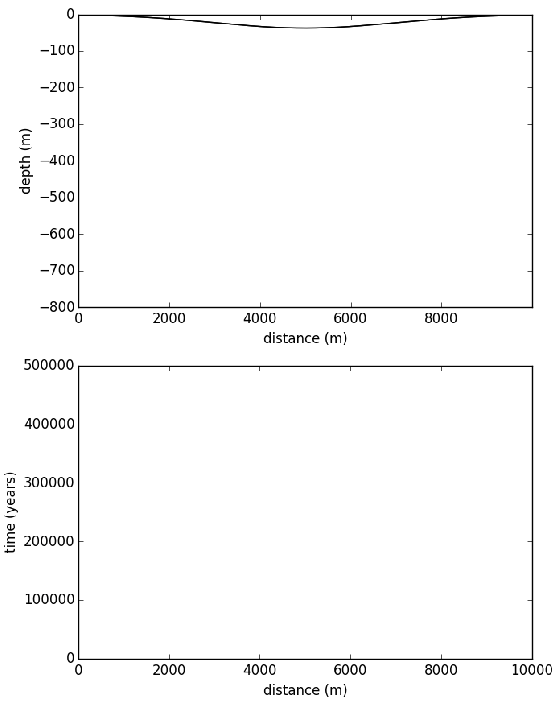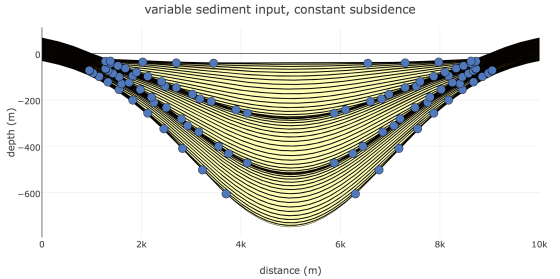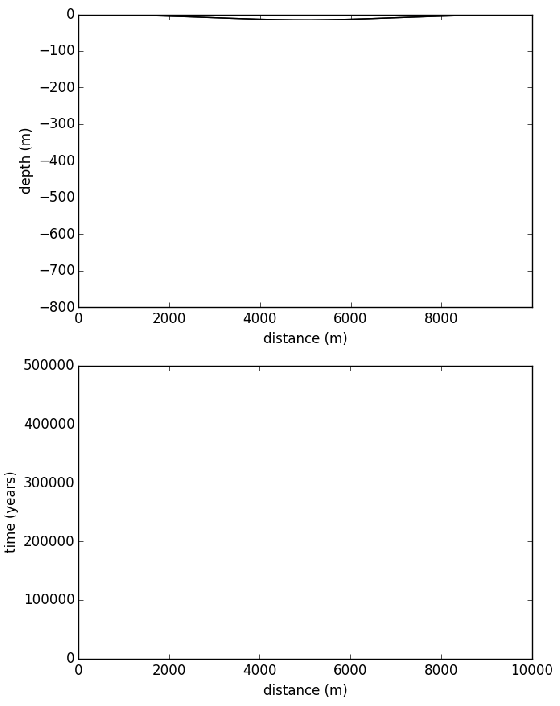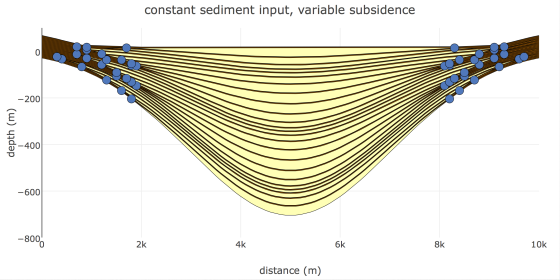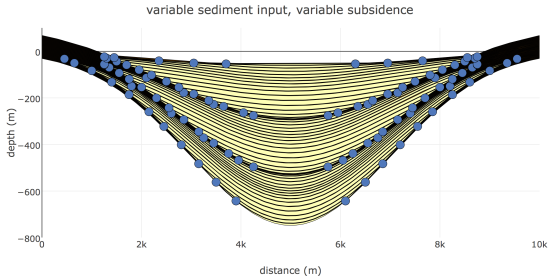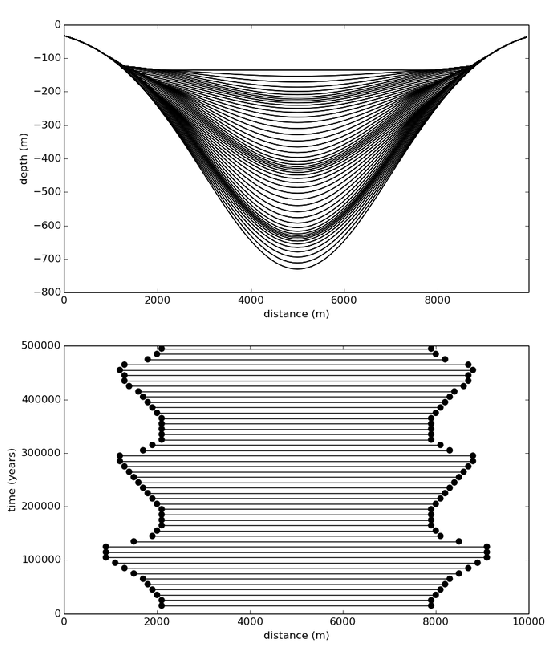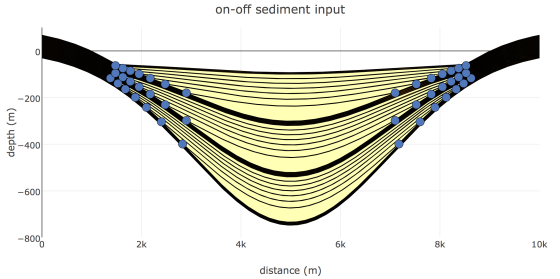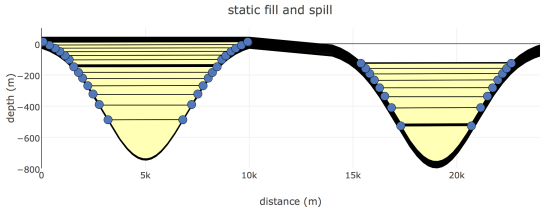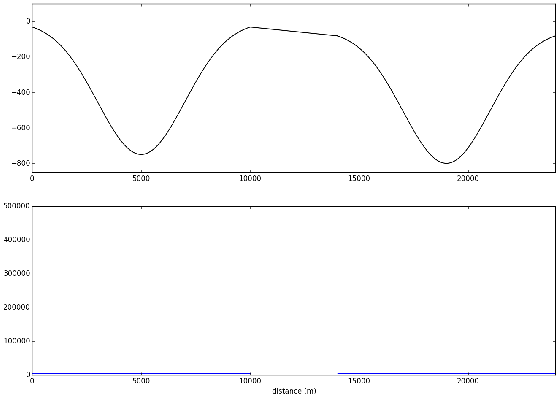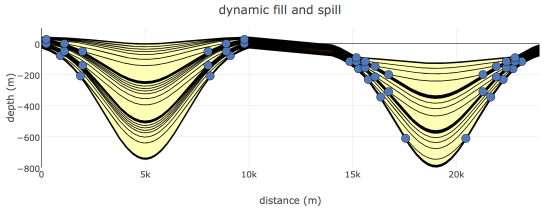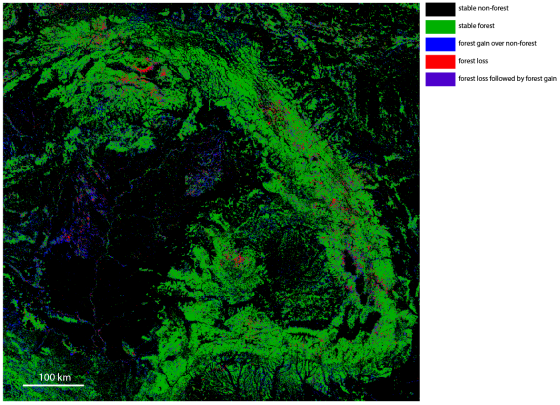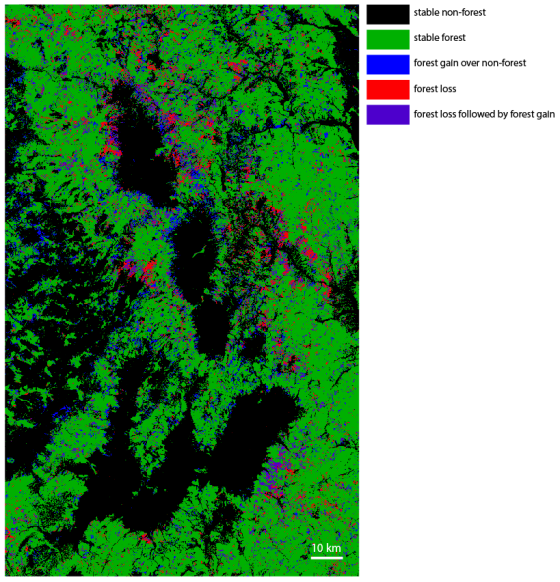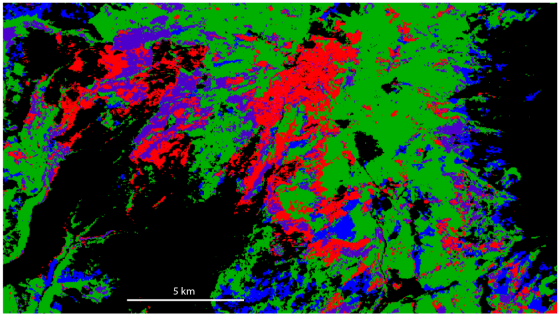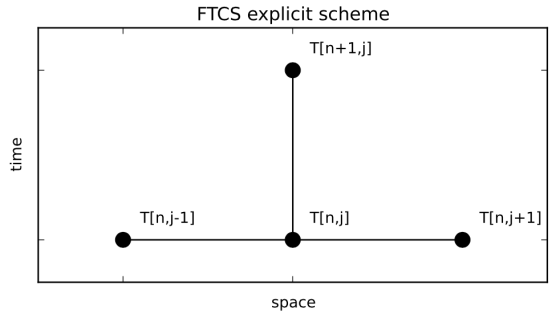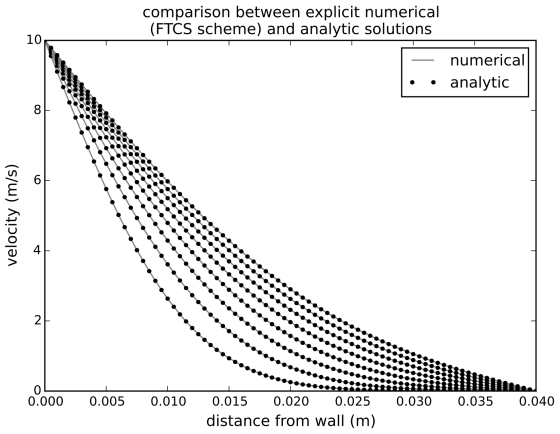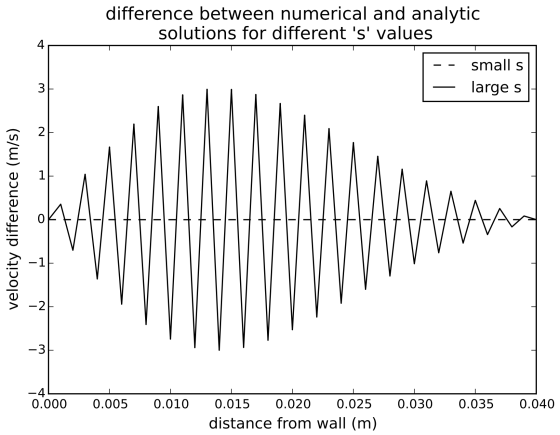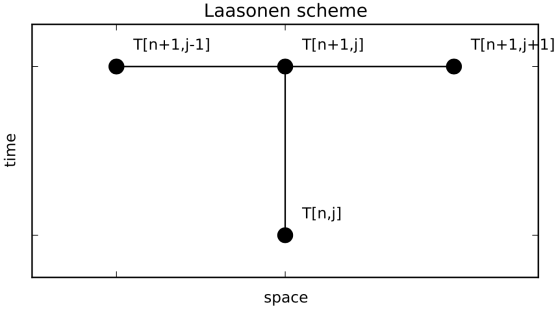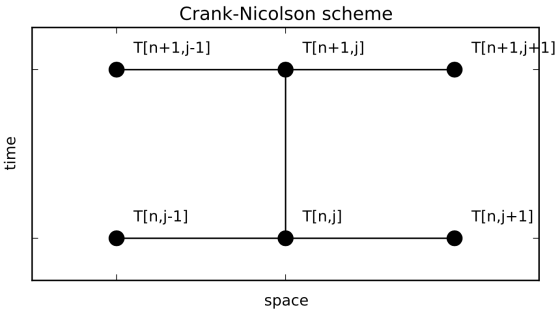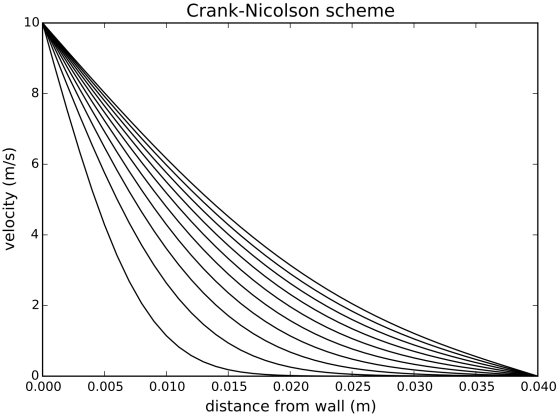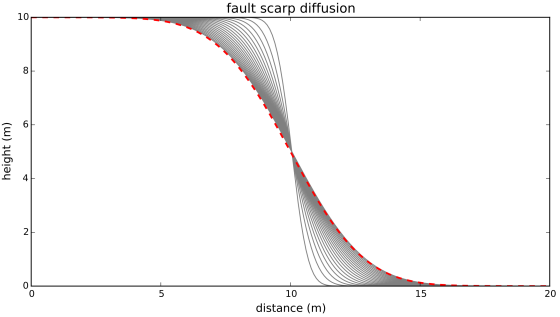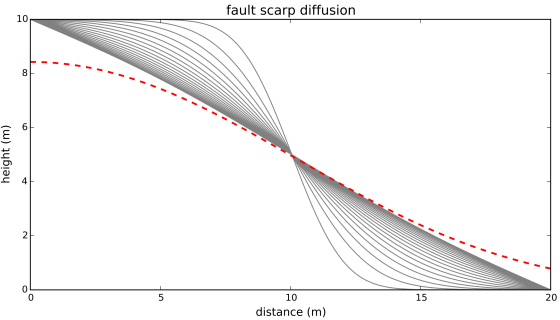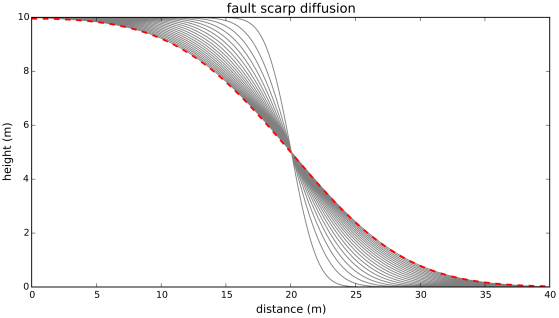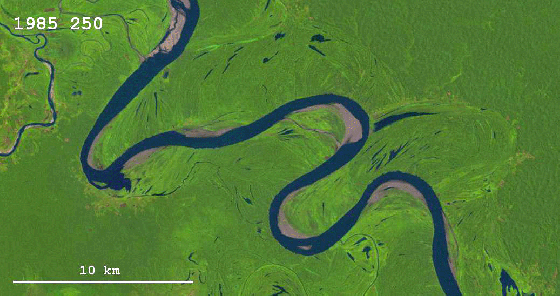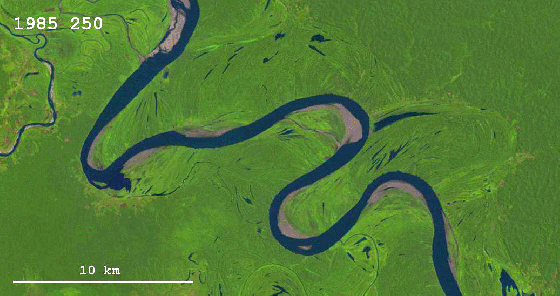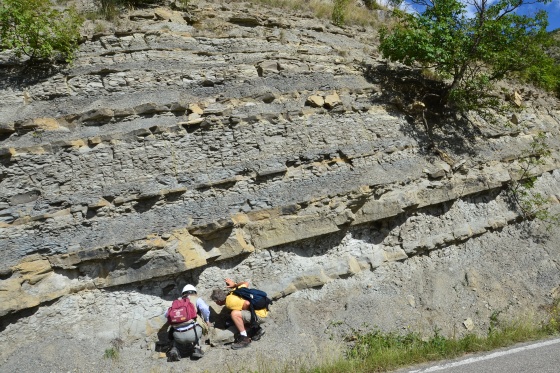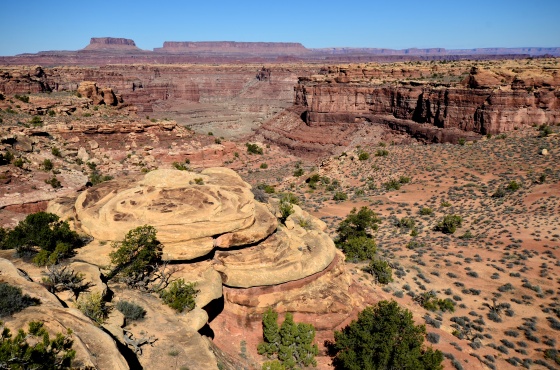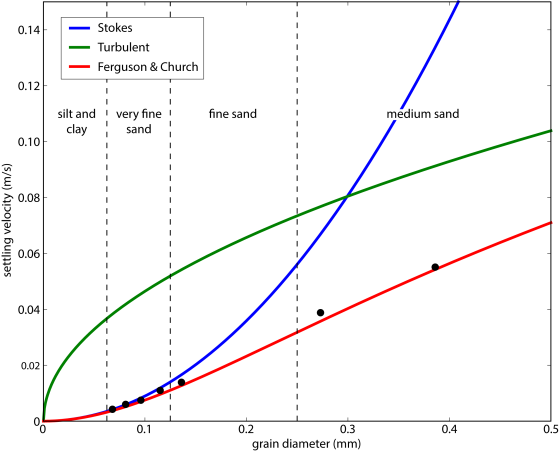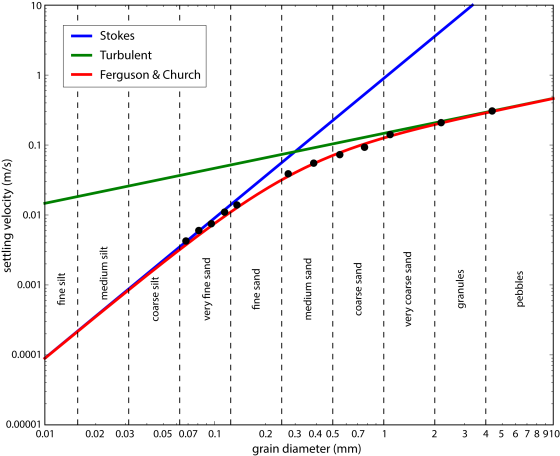All clastic sediments are subject to compaction (and reduction of porosity) as the result of increasingly tighter packing of grains under a thickening overburden. Decompaction – the estimation of the decompacted thickness of a rock column – is an important part of subsidence (or geohistory) analysis. The following exercise is loosely based on the excellent basin analysis textbook by Allen & Allen (2013), especially their Appendix 56. You can download the Jupyter notebook version of this post from Github.
Import stuff
import numpy as np import matplotlib.pyplot as plt import functools from scipy.optimize import bisect %matplotlib inline %config InlineBackend.figure_format = 'svg' plt.rcParams['mathtext.fontset'] = 'cm'
Posing the problem
Given a sediment column of a certain lithology with its top at and its base at
, we are trying to find the thickness and average porosity of the same sediment column at a different depth (see figure below). We are going to set the new top
and work towards finding the new base
.
plt.figure(figsize=(2,5))
x = [0,1,1,0,0]
y = [1,1,1.5,1.5,1]
plt.text(-0.6,1.02,'$y_1$',fontsize=16)
plt.text(-0.6,1.52,'$y_2$',fontsize=16)
plt.text(-0.6,1.27,'$\phi$',fontsize=16)
plt.fill(x,y,'y')
x = [3,4,4,3,3]
y = [0.5,0.5,1.15,1.15,0.5]
plt.text(2.25,0.52,'$y_1\'$',fontsize=16)
plt.text(2.25,1.17,'$y_2\'$',fontsize=16)
plt.text(2.25,0.9,'$\phi\'$',fontsize=16)
plt.fill(x,y,'y')
plt.plot([1,3],[1,0.5],'k--')
plt.plot([1,3],[1.5,1.15],'k--')
plt.gca().invert_yaxis()
plt.axis('off');

Porosity decrease with depth
Porosity decreases with depth, initially largely due to mechanical compaction of the sediment. The decrease in porosity is relatively large close to the seafloor, where sediment is loosely packed; the lower the porosity, the less room there is for further compaction. This decrease in porosity with depth is commonly modeled as a negative exponential function (Athy, 1930):
where is the porosity at depth
and
is the depth where the initial porosity
was reduced by
.
This is an empirical equation, as there is no direct physical link between depth and porosity; compaction and porosity reduction are more directly related to the increase in effective stress under a thicker overburden. Here we only address the simplest scenario with no overpressured zones. For normally pressured sediments, Athy’s porosity-depth relationship can be expressed in a slightly different form:
where c is a coefficient with the units . The idea is that c is a characteristic constant for a certain lithology and it can measured if porosity values are available from different depths. Muds have higher porosities at the seafloor than sands but they compact faster than sands. The plot below show some typical curves that illustrate the exponential decrease in porosity with depth for sand and mud. The continuous lines correspond to the parameters for sand and mud in Appendix 56 of Allen & Allen (2013); the dashed lines are exponential fits to data from the Ocean Drilling Program (Kominz et al., 2011).
c_sand = 0.27 # porosity-depth coefficient for sand (km-1)
c_mud = 0.57 # porosity-depth coefficent for mud (km-1)
phi_sand_0 = 0.49 # surface porosity for sand
phi_mud_0 = 0.63 # surface porosity for mud
y = np.arange(0,3.01,0.01)
phi_sand = phi_sand_0 * np.exp(-c_sand*y)
phi_mud = phi_mud_0 * np.exp(-c_mud*y)
plt.figure(figsize=(4,7))
plt.plot(phi_sand,y,'y',linewidth=2,label='sand')
plt.plot(phi_mud,y,'brown',linewidth=2,label='mud')
plt.xlabel('porosity')
plt.ylabel('depth (km)')
plt.xlim(0,0.65)
plt.gca().invert_yaxis()
c_sand = 1000/18605.0 # Kominz et al. 2011 >90% sand curve
c_mud = 1000/1671.0 # Kominz et al. 2011 >90% mud curve
phi_sand_0 = 0.407 # Kominz et al. 2011 >90% sand curve
phi_mud_0 = 0.614 # Kominz et al. 2011 >90% mud curve
phi_sand = phi_sand_0 * np.exp(-c_sand*y)
phi_mud = phi_mud_0 * np.exp(-c_mud*y)
plt.plot(phi_sand,y,'y--',linewidth=2,label='90% sand')
plt.plot(phi_mud,y,'--',color='brown',linewidth=2,label='90% mud')
plt.legend(loc=0, fontsize=10);

While the compaction trends for mud happen to be fairly similar in the plot above, the ones for sandy lithologies are very different. This highlights that porosity-depth curves vary significantly from one basin to another, and are strongly affected by overpressures and exhumation. Using local data and geological information is critical. As Giles et al. (1998) have put it, “The use of default compaction curves can introduce significant errors into thermal history and pore- fluid pressure calculations, particularly where little well data are available to calibrate the model.” To see how widely – and wildly – variable compaction trends can be, check out the review paper by Giles et al. (1998).
Deriving the general decompaction equation
Compacting or decompacting a column of sediment means that we have to move it along the curves in the figure above. Let’s consider the volume of water in a small segment of the sediment column (over which porosity does not vary a lot):
As we have seen before, porosity at depth y is
The first equation then becomes
But
and
where and
are the thicknesses that the water and total volumes occupy respectively, and A is the area of the column we are looking at. So the relationship is equivalent to
If we integrate this over the interval to
we get
Integrating this yields
As the total thickness equals the sediment thickness plus the water “thickness”, we get
The decompacted value of is
Now we can write the general decompaction equation:
That is,
The average porosity at the new depth will be
Write code to compute (de)compacted thickness
The decompaction equation could be solved in the ‘brute force’ way, that is, by gradually changing the value of until the right hand side (RHS) of the equation is the same as the left hand side (LHS) – see for example the Excel spreadsheet that accompanies Appendix 56 in Allen & Allen (2013). However, we (and scipy) can do better than that; we will use bisection, one the simplest optimization methods to find the root of the function that we set up as RHS-LHS.
# compaction function - the unknown variable is y2a
def comp_func(y2a,y1,y2,y1a,phi,c):
# left hand side of decompaction equation:
LHS = y2a - y1a
# right hand side of decompaction equation:
RHS = y2 - y1 - (phi/c)*(np.exp(-c*y1)-np.exp(-c*y2)) + (phi/c)*(np.exp(-c*y1a)-np.exp(-c*y2a))
return LHS - RHS
Now we can do the calculations; here we set the initial depths of a sandstone column to 2 and 3 kilometers, and we estimate the new thickness and porosity assuming that the column is brought to the surface (
).
c_sand = 0.27 # porosity-depth coefficient for sand (km-1) phi_sand = 0.49 # surface porosity for sand y1 = 2.0 # top depth in km y2 = 3.0 # base depth in km y1a = 0.0 # new top depth in km
One issue we need to address is that ‘comp_func’ six input parameters, but the scipy ‘bisect’ function only takes one parameter. We create a partial function ‘comp_func_1’ in which the only variable is ‘y2a’, the rest are treated as constants:
comp_func_1 = functools.partial(comp_func, y1=y1, y2=y2, y1a=y1a, phi=phi_sand, c=c_sand)
y2a = bisect(comp_func_1,y1a,y1a+3*(y2-y1)) # use bisection to find new base depth
phi = (phi_sand/c_sand)*(np.exp(-c_sand*y1)-np.exp(-c_sand*y2))/(y2-y1) # initial average porosity
phia = (phi_sand/c_sand)*(np.exp(-c_sand*y1a)-np.exp(-c_sand*y2a))/(y2a-y1a) # new average porosity
print('new base depth: '+str(round(y2a,2))+' km')
print('initial thickness: '+str(round(y2-y1,2))+' km')
print('new thickness: '+str(round(y2a-y1a,2))+' km')
print('initial porosity: '+str(round(phi,3)))
print('new porosity: '+str(round(phia,3)))
Write code to (de)compact a stratigraphic column with multiple layers
Next we write a function that does the depth calculation for more than one layer in a sedimentary column:
def decompact(tops,lith,new_top,phi_sand,phi_mud,c_sand,c_mud):
tops_new = [] # list for decompacted tops
tops_new.append(new_top) # starting value
for i in range(len(tops)-1):
if lith[i] == 0:
phi = phi_mud; c = c_mud
if lith[i] == 1:
phi = phi_sand; c = c_sand
comp_func_1 = functools.partial(comp_func,y1=tops[i],y2=tops[i+1],y1a=tops_new[-1],phi=phi,c=c)
base_new_a = tops_new[-1]+tops[i+1]-tops[i]
base_new = bisect(comp_func_1, base_new_a, 4*base_new_a) # bisection
tops_new.append(base_new)
return tops_new
Let’s use this function to decompact a simple stratigraphic column that consists of 5 alternating layers of sand and mud.
tops = np.array([1.0,1.1,1.15,1.3,1.5,2.0]) lith = np.array([0,1,0,1,0]) # lithology labels: 0 = mud, 1 = sand phi_sand_0 = 0.49 # surface porosity for sand phi_mud_0 = 0.63 # surface porosity for mud c_sand = 0.27 # porosity-depth coefficient for sand (km-1) c_mud = 0.57 # porosity-depth coefficent for mud (km-1) tops_new = decompact(tops,lith,0.0,phi_sand_0,phi_mud_0,c_sand,c_mud) # compute new tops
Plot the results:
def plot_decompaction(tops,tops_new):
for i in range(len(tops)-1):
x = [0,1,1,0]
y = [tops[i], tops[i], tops[i+1], tops[i+1]]
if lith[i] == 0:
color = 'xkcd:umber'
if lith[i] == 1:
color = 'xkcd:yellowish'
plt.fill(x,y,color=color)
x = np.array([2,3,3,2])
y = np.array([tops_new[i], tops_new[i], tops_new[i+1], tops_new[i+1]])
if lith[i] == 0:
color = 'xkcd:umber'
if lith[i] == 1:
color = 'xkcd:yellowish'
plt.fill(x,y,color=color)
plt.gca().invert_yaxis()
plt.tick_params(axis='x',which='both',bottom='off',top='off',labelbottom='off')
plt.ylabel('depth (km)');
plot_decompaction(tops,tops_new)
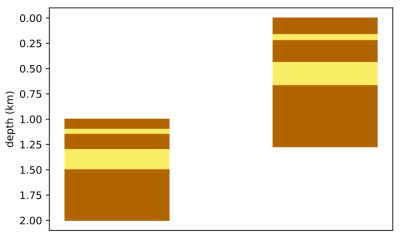
Now let’s see what happens if we use the 90% mud and 90% sand curves from Kominz et al. (2011).
tops = np.array([1.0,1.1,1.15,1.3,1.5,2.0]) lith = np.array([0,1,0,1,0]) # lithology labels: 0 = mud, 1 = sand c_sand = 1000/18605.0 # Kominz et al. 2011 >90% sand curve c_mud = 1000/1671.0 # Kominz et al. 2011 >90% mud curve phi_sand_0 = 0.407 # Kominz et al. 2011 >90% sand curve phi_mud_0 = 0.614 # Kominz et al. 2011 >90% mud curve tops_new = decompact(tops,lith,0.0,phi_sand_0,phi_mud_0,c_sand,c_mud) # compute new tops plot_decompaction(tops,tops_new)
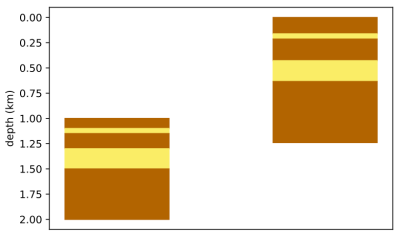
Quite predictably, the main difference is that the sand layers have decompacted less in this case.
That’s it for now. It is not that hard to modify the code above for more than two lithologies. Happy (de)compacting!
References
Allen, P. A., and Allen, J. R. (2013) Basin Analysis: Principles and Application to Petroleum Play Assessment, Wiley-Blackwell.
Athy, L.F. (1930) Density, porosity and compaction of sedimentary rocks. American Association Petroleum Geologists Bulletin, v. 14, p. 1–24.
Giles, M.R., Indrelid, S.L., and James, D.M.D., 1998, Compaction — the great unknown in basin modelling: Geological Society London Special Publications, v. 141, no. 1, p. 15–43, doi: 10.1144/gsl.sp.1998.141.01.02.
Kominz, M.A., Patterson, K., and Odette, D., 2011, Lithology Dependence of Porosity In Slope and Deep Marine Sediments: Journal of Sedimentary Research, v. 81, no. 10, p. 730–742, doi: 10.2110/jsr.2011.60.
Thanks to Mark Tingay for comments on ‘default’ compaction trends.


